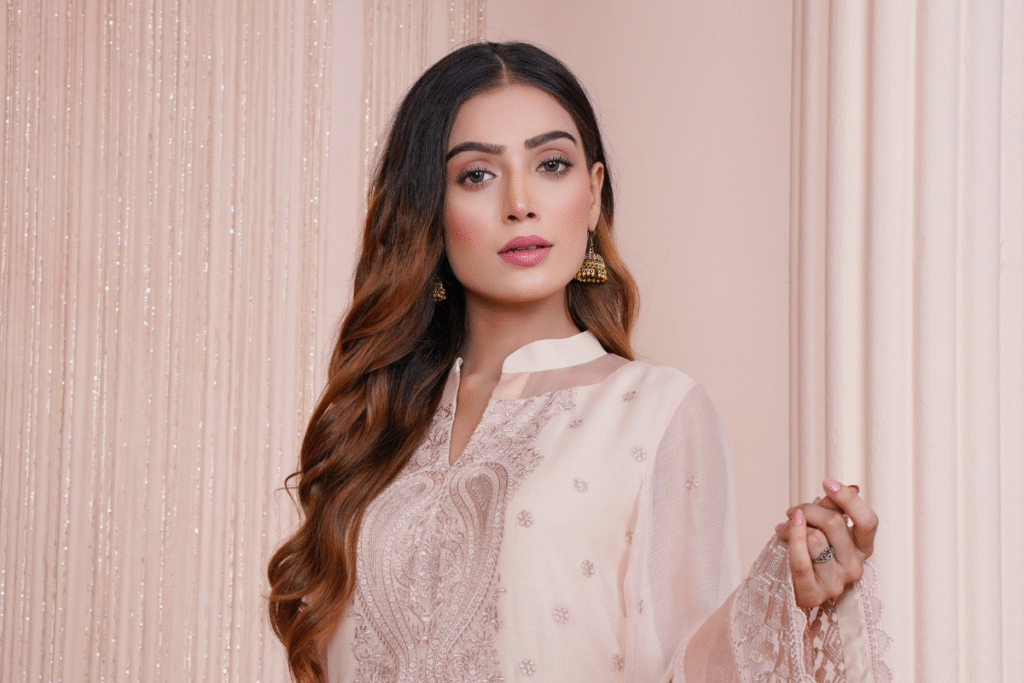The dupatta is more than just an accessory – it’s a statement piece that can make or break your ethnic ensemble. But here’s what many fashion enthusiasts overlook: choosing the right fabric for each season is crucial for both comfort and style. Whether you’re dealing with scorching summers or chilly winters, selecting the appropriate dupatta fabric can transform your entire look while keeping you comfortable throughout the day.
In this comprehensive guide, we’ll explore the best dupatta fabrics for every season, helping you build a versatile collection that works year-round.
Understanding Dupatta Fabric Properties
Before diving into seasonal recommendations, it’s essential to understand what makes certain fabrics suitable for specific weather conditions. The key factors include:
Breathability: How well the fabric allows air circulation Weight: The heaviness or lightness of the material Drape: How the fabric falls and moves Moisture absorption: The fabric’s ability to absorb or repel moisture Durability: How well the fabric withstands wear and washing
Summer Dupatta Fabrics: Beat the Heat in Style
Summer calls for lightweight, breathable fabrics that keep you cool while maintaining elegance.
Cotton: The Summer Champion
Cotton dupatta remains the most practical choice for hot weather. Its natural fibers allow excellent air circulation, making it perfect for daily wear. Cotton dupatta comes in various weaves:
- Mulmul cotton: Ultra-lightweight and soft
- Khadi cotton: Handwoven with a rustic charm
- Printed cotton: Available in vibrant summer prints
Cotton dupatta works exceptionally well with cotton suits and casual ethnic wear. They’re easy to maintain and can withstand frequent washing.
Chiffon: Elegant and Airy
Chiffon dupatta offers the perfect balance of style and comfort for summer occasions. This sheer, lightweight fabric creates beautiful drapes and adds a touch of sophistication to any outfit. Chiffon dupatta is ideal for:
- Evening parties during summer
- Office wear in air-conditioned environments
- Semi-formal occasions
Georgette: Versatile Summer Option
Georgette dupatta provides slightly more structure than chiffon while remaining breathable. It’s perfect for those who prefer a fabric with more body but still want summer comfort.
Monsoon Dupatta Fabrics: Stay Stylish in the Rain
Monsoon season requires fabrics that dry quickly and resist moisture damage.
Synthetic Blends: Practical and Pretty
During rainy season, synthetic dupatta or poly-blend fabrics work wonders. They:
- Dry quickly when wet
- Resist wrinkles
- Maintain color vibrancy
- Are more affordable than natural fabrics
Crepe: Weather-Resistant Elegance
Crepe dupatta offers excellent wrinkle resistance and quick-drying properties, making it perfect for unpredictable monsoon weather.
Winter Dupatta Fabrics: Warmth Meets Fashion
Cold weather demands heavier fabrics that provide warmth without compromising on style.
Wool: Traditional Warmth
Wool dupatta is a winter wardrobe essential. Available in various weights:
- Pashmina: Luxuriously soft and warm
- Cashmere blend: Premium comfort and warmth
- Regular wool: Affordable warmth for everyday wear
Wool dupatta pairs beautifully with winter suits and adds a cozy layer to your outfit.
Silk: Luxurious Winter Choice
Silk dupatta provides natural insulation while maintaining elegance. Different silk varieties offer varying weights:
- Banarasi silk: Heavy and ornate for special occasions
- Tussar silk: Medium weight with natural texture
- Mulberry silk: Smooth and lustrous
Velvet: Rich and Warm
Velvet dupatta adds opulence to winter outfits. Its thick pile provides warmth while creating a rich, luxurious appearance perfect for wedding seasons and formal events.
Spring/Autumn Dupatta Fabrics: Transitional Comfort
These transitional seasons require versatile fabrics that adapt to changing temperatures.
Modal: Modern Comfort
Modal dupatta offers the softness of silk with the breathability of cotton. It’s perfect for unpredictable spring and autumn weather.
Linen Blends: Natural Elegance
Linen-blend dupatta provides breathability with added structure, making it ideal for transitional weather when you need something between summer lightness and winter weight.
Organza: Structured Sophistication
Organza dupatta offers more structure than chiffon while remaining relatively lightweight, perfect for spring and autumn occasions.
Fabric Care Tips by Season
Summer Care
- Wash cotton dupatta frequently to maintain freshness
- Store chiffon dupatta properly to prevent snags
- Use gentle detergents for delicate fabrics
Winter Care
- Dry clean wool and silk dupatta professionally
- Store with moth repellents
- Air out occasionally to prevent mustiness
General Care
- Always check care labels before washing
- Use fabric-appropriate storage methods
- Rotate your dupatta collection seasonally
Building Your Seasonal Dupatta Wardrobe
Creating a well-rounded dupatta collection requires strategic planning:
Essential Summer Collection: 3-4 cotton, 2 chiffon, 1-2 georgette dupatta Monsoon Must-haves: 2-3 synthetic blends, 1-2 crepe dupatta Winter Wardrobe: 2-3 wool varieties, 2 silk dupatta, 1 velvet for special occasions Transitional Pieces: 2 modal, 1 linen blend, 1 organza dupatta
Color Considerations by Season
Your dupatta fabric choice should also consider seasonal color trends:
- Summer: Light, bright colors in breathable fabrics
- Monsoon: Darker shades that hide stains
- Winter: Rich, deep colors in luxurious fabrics
- Spring/Autumn: Earth tones and pastels in versatile fabrics
Budget-Friendly Options
Building a seasonal dupatta wardrobe doesn’t have to break the bank:
- Cotton and cotton blends: Most affordable for daily wear
- Synthetic fabrics: Budget-friendly and practical
- Mixed collections: Invest in one premium piece per season, fill with affordable basics
Conclusion
Choosing the right dupatta fabric for each season enhances both your comfort and style quotient. From breathable cotton for summer to luxurious wool for winter, each fabric serves a specific purpose in your ethnic wardrobe. Remember, the best dupatta is one that makes you feel confident while keeping you comfortable in any weather.
Start building your seasonal dupatta collection gradually, focusing on versatile pieces that can transition between occasions. With the right fabrics in your wardrobe, you’ll always have the perfect dupatta to complete your ethnic ensemble, regardless of the season.
Whether you’re shopping for your first dupatta or expanding your existing collection, use this guide to make informed choices that will serve you well throughout the year. After all, a well-chosen dupatta is not just an accessory – it’s your style signature in every season.


